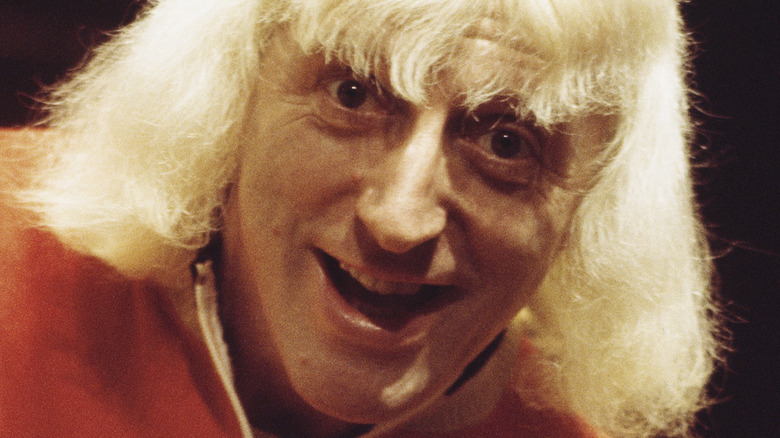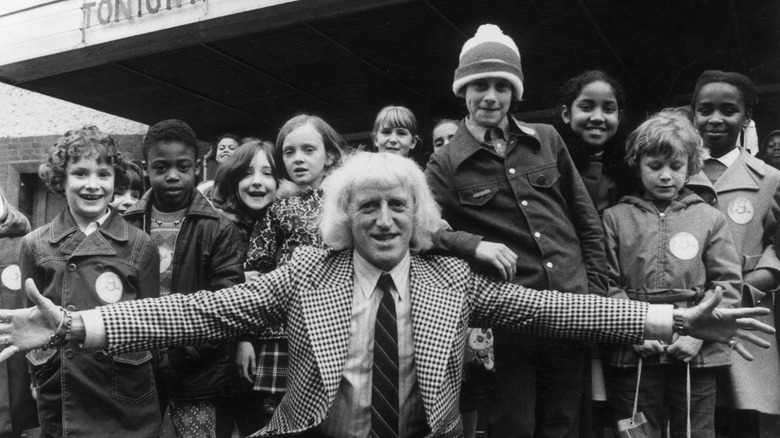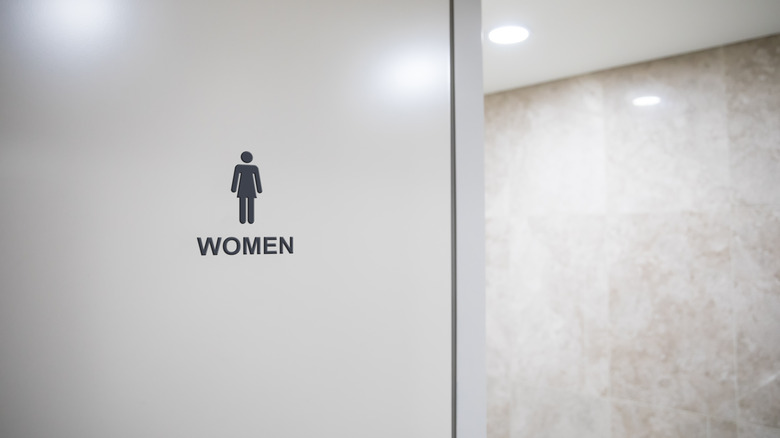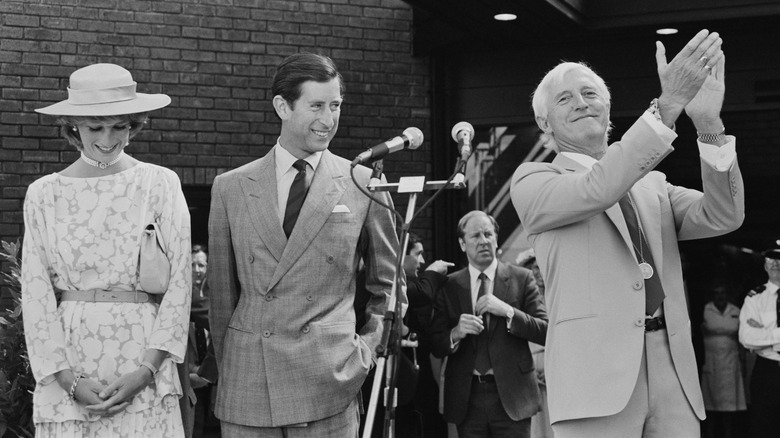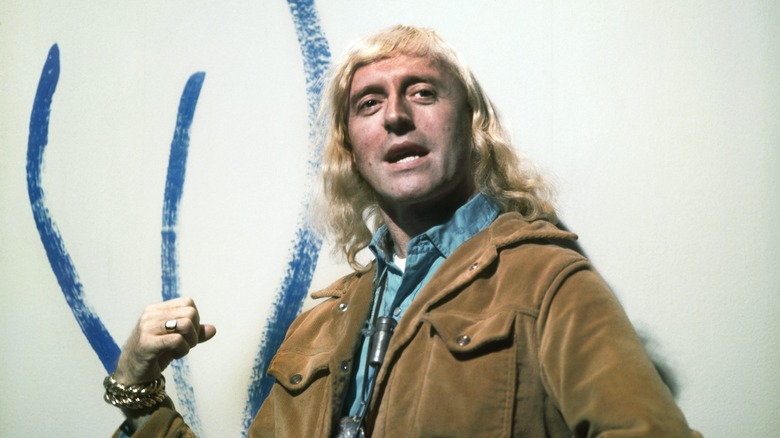How Many Suspected Victims Did Jimmy Savile Have?
The following article includes allegations of child sex abuse, sexual assault, and necrophilia.
Born in Leeds, England in 1926, Jimmy Savile went on to become a household name as a media personality, hosting shows like Britain's "Top of the Pops" and "Jim'll Fix It." However, as The Guardian reported three years after his death in 2011, Savile would go on to become one of the most abhorrent alleged pedophiles and sex criminals of the 20th century after his scores of victims reported claims of abusive behavior. And while Savile's death precluded any formal charges by British authorities, a 30-page report released by the Metropolitan Police Service and the National Society for the Prevention of Cruelty to Children (NSPCC) in 2013 concluded that Savile's guilt was more or less a foregone conclusion, a 2013 piece by The Guardian noted.
Per The Guardian, one of Savile's very first purported victims was abused while Savile was managing a dance club in 1955. In 1958, Savile became a DJ for the broadcaster Radio Luxemburg. Around 1960, Savile began to take advantage of his stardom. Another one of the earliest reported claims against Savile was later made by a person who, at the time the crime took place in 1960, was a 10-year-old child. After asking Savile for his autograph, Savile took the child to his hotel room and sexually assault him. But since the public remained unaware of his crimes for decades, Savile's career continued to thrive, taking off when he became the presenter for the BBC's "Top of the Pops" in 1964.
Jimmy Savile targeted hospital patients and vulnerable children
Per The Guardian, Jimmy Savile committed a staggering number of offenses in the 1960s. Aside from finding victims through his job at the BBC, Savile used his volunteer work and philanthropic ventures at hospitals — among them Leeds Hospital and Stoke Mandeville Hospital — to do the same. He also gained access to the Duncroft Approved School for Girls, where female minors deemed to have emotional and behavioral issues were sent to live apart from their families, in the 1970s, according to the BBC. Over a five-year period, Savile was given access to the Duncroft campus British authorities categorized as "unrestricted and largely unsupervised" to the BBC, going as far as to sometimes stay there overnight.
In October 1972, Savile's mother, Agnes Savile, died — and while her son ostensibly had a close relationship with her, and even shared a residence with her, it seems there was more to it than met the eye, per the U.K. Mirror. In one interview, Savile claimed to spend five days with his mother's body after her death; in the same interview, he called them "the best five days of my life," due to the fact that Agnes was "all mine." (As another article by The Guardian noted in 2014, Savile was later suspected to have engaged in interfering with corpses at Leeds Hospital, if not outright necrophilic acts.)
Jimmy Savile's show Jim'll Fix It served as a cover for his crimes
In 1975, "Jim'll Fix It" aired on television for the first time, and with Jimmy Savile as the host, it ultimately transformed his already-successful career; but as The Guardian noted in 2016, it also gave Savile access to even more victims. In this long-running reality show, which aired for 19 years, Jim would read letters from children who asked for Savile to grant their wishes. Then Savile would make one child's wish come true — by bringing a child onto the show to meet a celebrity guest, for instance, or do a fun activity that they requested.
The children's show aired once per week and ran for twenty seasons, giving Savile a regular victim pool. According to a 2016 BBC report, Savile's actions weren't carefully concealed by the presenter, and that was enough to warrant the producer of "Jim'll Fix It," Roger Ordish, to warn staff that "he [Savile] should not be left alone with children." At the same time Savile gained greater prominence with the U.K. public as the program's host, Savile remained a mainstay at children's homes and residential schools. Among those Savile frequented was Northways Residential School located near the city of Leeds — which, like Duncroft Approved School for Girls, catered to "troubled" minors. As a 2014 report released by the Leeds City Council revealed, Savile invited children to visit him at his home, with some staying overnight.
Jimmy Savile carried keys to any room in the hospital
Even while hosting "Jim'll Fix It," Jimmy Savile continued to frequent not just schools, but hospitals — including Broadmoor Hospital, a psychiatric institution best known for incarcerating convicted inmates deemed criminally insane in its high-security facilities. At Broadmoor, Savile had keys to access to any room, a privilege he held for over 30 years, per The Guardian. Here he abused children as young as 5, as well as elderly victims, who were as old as 75.
Taking advantage of his star power that could get him into any room, he enjoyed watching female patients as they did mandatory clothing changes in front of staff members. Savile would then stand in the doorway of the restroom as the women showered and made inappropriate remarks in front of them (via Independent). With his own set of keys, he could follow the women wherever they went.
According to a report later released by the U.K.'s Department of Health (via The Guardian), people who worked at Broadmoor at that time said there was a permissive culture that allowed staff and patients to have relationships. Savile was given a managerial position at Broadmoor in 1988. Lots of these victims alerted the hospital about Savile's sickening abuse but were ignored. In fact, he only stopped visiting the Broadmoor hospital in 2004, as stricter security measures were put into place to protect patients, per The Guardian.
Jimmy Savile was knighted for his fundraising work
As the 1990s rolled around Jimmy Savile remained beloved by fans of "Top of the Pops" and "Jim'll Fix It," both of which touted large viewerships, per The Guardian. It was also the decade that Savile was granted a papal knighthood, specifically in 1990. As The New York Times reported shortly after Savile's 2011 death, the media presenter held fundraisers that garnered tens of millions of dollars for hospitals and bolstered his reputation as a respected figure. It also meant he rubbed elbows with former Prime Minister Margaret Thatcher and the British royal family — although Savile's own past claims of how close he actually was with Thatcher or the Windsors aren't fully reliable, per The New York Times.
Savile's TV show "Jim'll Fix It" finally ended in 1994 — and so, too, did his primary cover of plausible deniability for being around children. Four years later, Savile was asked by documentarian Louis Theroux during the filming of his 2000 Savile-centric documentary "When Louis Met ... Jimmy" about Savile's possible pedophilia, which Savile denied (via NME).
What happened to Jimmy Savile?
An allegedly serial perpetrator like Jimmy Savile might have spent time in jail if his crimes had come to light sooner. But unfortunately, Savile never faced any consequences for his actions, dying at age 84 in 2011 (via The New York Times). In June 2014, the U.K.'s National Health Service and Department of Health jointly published 44 reports detailing investigations into the many, many cases of Savile's abuse.
As the case was investigated, it showed that people didn't realize the risk of pedophiles at that time, especially in places like schools — though later on, numerous schools updated their security policies in light of the Savile case (via the BBC). As of this writing, it is believed that the total number of alleged cases of abuse at the hands of Savile is 589, per the BBC, and that the majority of victims were female minors. According to Leeds Live, Savile's lifetime of sexual assault, abuse, and more was so unforgivable that his tombstone was removed from his grave.
If you or anyone you know has been a victim of sexual assault, help is available. Visit the Rape, Abuse & Incest National Network website or contact RAINN's National Helpline at 1-800-656-HOPE (4673).
If you or someone you know may be the victim of child abuse, please contact the Childhelp National Child Abuse Hotline at 1-800-4-A-Child (1-800-422-4453) or contact their live chat services.
